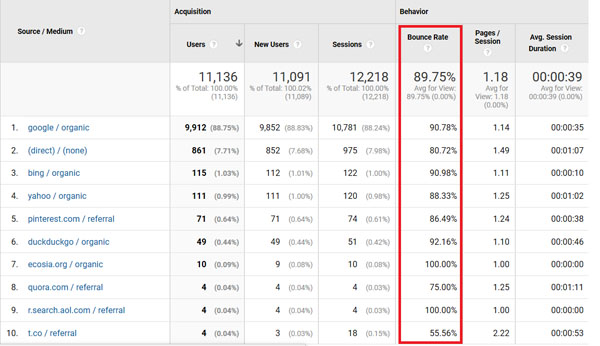If you are not familiar with the bounce rate, it is basically the number of visitors who only view one page on your blog before leaving it.
Some poorly optimized WordPress blogs have bounce of rate of up to 90%.
Just imagine, potentially 90% of your visitors are leaving your post before reading it.
Even a small improvement in bounce rate can significantly increase your revenue.
Decreasing the bounce rate from 90% to 80% pretty much doubles the number of engaged visitors on your website which is equivalent to getting twice the amount of traffic.
Many suggestions that we are going to discuss take less than half an hour to implement but can have a dramatic effect on the user experience on your blog.
Why High Bounce Rate is BAD?

- First of all, it might indicate that your visitors are not finding the information that they are looking for.
- Secondly, your visitors are not converting into email subscribers or buyers.
- Lastly, pages with high bounce rates are penalized by Google search.
Reasons for High Bounce Rate on Your Blog
There are always will be visitors who will leave your blog as soon they arrive but if your bounce rate is above 70%, it means that your pages are not fully optimized and you are losing on a lot of potential revenue.
It is important to understand the limits of bounce rate metric as well.
For example, if someone visits your post and spends 10 minutes reading it and then leaves without visiting any other pages the bounce rate will be 100%.
That’s why the goal shouldn’t be to get a 0% bounce rate but instead keep it a little lower than your competitors.
Here are some common reason for high bounce rate on WordPress blogs.
- Slow loading pages. If it takes a long time for a page to load, visitors might get frustrated and leave before your page fully loads.
- Low-quality content. If you have poorly written content that can’t answer the questions that your visitors were looking for they will leave before looking at any other pages on your blog. It takes time to become good at blogging and your content will improve as you practice writing more articles. However, spun article (slightly altering somebody’s else articles to make your own content) or content created by third-party low-quality writers that charge $10 per 1000 word article will always have a high bounce rate.
- A large number of ads. Most people hate websites that have too many ads that make it hard to read the actual post content and they usually leave right away. Don’t overdo with your ads. Too many ads will also slow down your page.
- Irrelevant traffic. If your page is ranked for a wrong keyword or if you are receiving a lot of untargeted social traffic your bounce rate will be higher simply because your visitors are not looking for what you have to offer.
How to Decrease Your Bounce Rate?
One of the best free tools to optimize your bounce rate is Google Analytics.
With Google Analytics you can find low performing pages with a high bounce rate and then look into each page in depth to optimize it.
1. Increase the speed of your blog.
There are several easy ways to make your pages load faster.
A great tool to use to check the speed of your pages is PageSpeed Insights from Google.
PageSpeed Insights shows the loading both for mobile and desktop versions of your website. They also provide recommendations on how to decrease the loading times.
- Optimize your images. Don’t just upload images directly from your phone to your website. The images from modern smartphones are huge. I use Photoshop to optimize the size of my images but there are many other image editors that can do the same. There are also WordPress plugins like Smush that can decrease the size of your images even further. In many cases, you will be able to decrease the size of your images by up to 97%.
- Get a fast hosting. Not every hosting is the same and while cheaper options will work for smaller websites it might be beneficial to get something faster if you have a more complex website.
- Use an optimized WordPress theme. Not every WordPress theme is the same and not every beautiful theme is fast. Before getting the theme check to make that it is optimized for mobile.
- Use the Content Delivery Network (CDN). CDN works by storing a copy of your content on different servers around the world. When someone visits your website, they get the data from the servers located the closest to them.
- Use Caching plugins. These plugins can increase the speed of your pages by serving them in static HTML format instead of PHP scripts.
- Remove all the plugins that you are not using.
2. Make sure your website is mobile responsive.
There is no away around it. Most people are using their phones to browse the Internet.
If your website design is not mobile responsive, your bounce rate will stay high and it will be hard to rank high in Google.
Most new WP themes are mobile responsive.
3. Increase the readability of your posts.
All posts should be easy to read.
Here are some general tips on how to make your posts easier to read and more engaging:
- Keep your paragraphs short. Many of your visitors will be using a mobile device to read your posts. No one wants to look at the page full of text without any breaks. One or two sentences per paragraph are usually more than enough.
- Use a bigger font. It is easier to read posts written in slightly bigger size font 18 px or 19 px vs. standard 16 px.
- Use shorter sentences. It is easier to skim over shorter sentences.
- Use bullet or number lists. This helps to add more structure to your posts.
4. Use images in your posts.
People get tired reading pages full of text without any visual data.
Using high quality images can significantly increase the engagement on your pages.
You can either take photos yourself or buy them from royalty-free websites like Shutterstock.
Alternatively you can look into free stock image websites.
5. Add relevant links to your posts.
Adding more relevant links to your posts will make it easier for people to visit more than one page on your blog.
Many blogs have high bounce rate just because visitors have no idea what to do next after reading a post.
6. Add a table of contents.
Table of contents makes it easier for visitors to navigate your page and it also increases Google ranking.
Allowing your visitors to quickly find what they came for will decrease your bounce rate.
Table of contents is especially useful when viewing long-form content on a smartphone.
If you are using WordPress, you can use Easy Table of Contents (TOC) – plugin to automatically insert a table of contents into all of your posts.
You post will need to have H1 and H2 header tags for this plugin to work.
7. Update you older posts.
Some of your older posts might be out of date and contain old information which is not applicable to your visitors.
Updating it will not only decrease the bounce rate on those pages but you might also start seeing additional traffic from Google.
8. Make your external links open in a new tab.
You don’t want your visitors to leave your website by clicking on the links to external sites.
9. Work on your copywriting skills.
Creating engaging content is one of the best ways to keep your visitors from leaving your blog.
Getting good at copywriting takes time and practice.
Backlinko has amazing free The Definitive Guide to Copywriting that can help you to improve your copywriting skills.
10. Write longer posts.
With longer posts, you will keep your visitors longer on your blog and this will give them more opportunities to click on the links to your other pages.
Another advantage of creating long-form content is better ranking in Google.
Long in-depth posts are preferred by Google over shorter content.
You probably already noticed that most of the posts that are ranked high in Google are super long. Some of those long posts can be up to 10,000 words, which is a little extreme in my opinion.
You don’t have to spend a month writing your blog posts and 1500-3000 words should be enough.
11. Have a strong call to action.
Make your call to action easy to find.
You don’t want your visitors to read the information on your page and then leave without subscribing to your email list or making a purchase.
12. Use a compelling hook.
The hook is simply a piece of well-crafted text that grabs your visitor’s attention and prevents him or her from leaving your page.
You will need at least two hooks: one at the top of the article and one at the bottom.
This is will help to decrease the bounce rate by guiding your visitors on what to do next.
13. Limit number of ads.
Most people hate ads. Especially irrelevant ads.
If you go overboard with your ads, your bounce rate will increase.
If you implement the steps above, you should start seeing improvement in your bounce rate.
Did you know that your internet service provider can track your online activity? Want to hide your identity online and keep your browsing habits private? Try NordVPN!
*This post might contain affiliate links. If you click on a link, I might receive a small commission.

